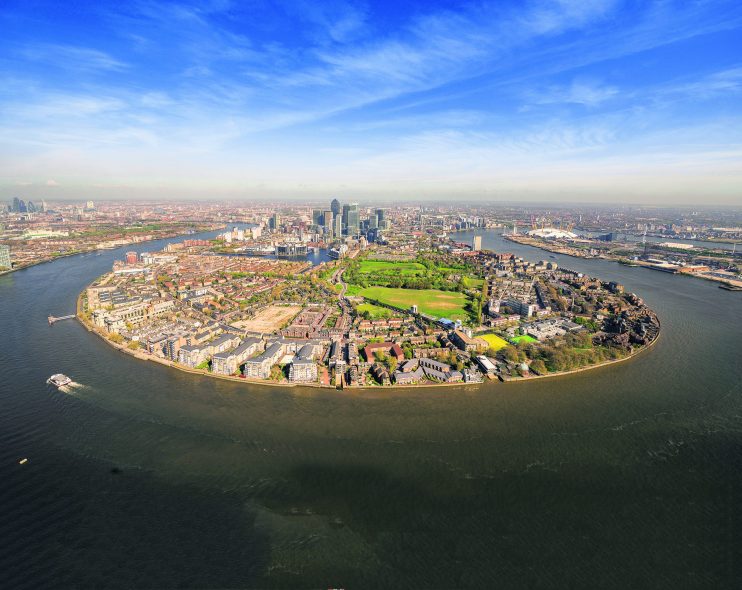Focus on Isle of Dogs: Dog days are over for once-neglected peninsula as new development abounds

There are two questions that residents of the Isle of Dogs are often asked. First, why is it called the Isle of Dogs?
The boring explanation is that it’s a corruption of a more sensible water-related name like the Isle of Ducks. The grim one is that it was so called because of the sheer volume of dead dogs that once washed up there. Probably the most plausible is that Edward III, who hunted in Greenwich Park across the river, kept his greyhounds there.
The second question: is it actually an island? No – it’s a peninsula, bounded on three sides by the deepest bend in the Thames, but attached to Canary Wharf and Poplar to the North.
The former heart of London’s Docklands was historically a bit isolated – before the arrival of the Jubilee Line in 1999 it was only accessible by DLR, and pre-1987 only by bus – but that’s slowly starting to change as more housing and amenities spring up.
“The Isle of Dogs is having a renaissance,” says James Hyman, head of residential at Cluttons. “People are waking up to it representing value for money in a housing market which is mainly being driven by affordability.”
It now finds itself slap bang in the middle of three regeneration hotspots: London City Island to the East, Wood Wharf to the North and Greenwich Peninsula to the South. Ambassadors for ‘The Island’ (as it’s known by locals) are set to grow in number too, thanks to a slew of big new developments which will bring thousands of new residents there.
The controversial £1bn Westferry Printworks, a former printing press owned by newspaper tycoon Richard Desmond, is about to be turned into 1,524 flats, having been given the green light in January after years of planning back-and-forth. And another scheme, Landmark Pinnacle, will be Europe’s tallest residential tower at a whopping 230 metres when it completes later this year. Apartments are still available there, with studios starting at £597,000.
Condense your commute
The average house price on the Isle of Dogs falls somewhere in between these shiny new-builds and the late 20th century housing stock that dominates the rest of the island, most of which was built after the docks were closed down in the early 1980s.
It currently sits at £481,830 according to Hamptons International: a 5.6 per cent drop year on year, and a modest 10 per cent increase in the last five. Prices are just above the London average, but could prove good value for City commuters.
“The Isle of Dogs is 33 per cent cheaper than Canary Wharf itself, but it’s within walking distance,” Hyman adds. It is also less than 20 minutes into Bank on the DLR, and Canary Wharf tube will also get you to Bond Street in 17 minutes.
Although its social scene leaves a little to be desired, the Isle of Dogs could be a savvy first step on the ladder for a young City professional, and according to Hamptons International one third of buyers in 2019 were first-timers. But it also suits City couples looking for their first family home. The average house will set you back £673,000 according to Hamptons International.
“Demand has shifted towards houses recently,” says Lee O’Neill, partner and head of Knight Frank’s Canary Wharf office. “While these buyers still need to live close to work, they are thinking longer-term and prioritising things like outdoor space.”
Period properties were mostly knocked down as part of the dock clearance, but the great thing about living on a peninsula is there is no shortage of river frontage.
“The river-fronted townhouses of Mariners Mews and Quadrant Walk achieve top prices, with buyers prepared to pay a premium for the waterside position,” says Frances Clacy, research analyst at Savills.
Its name and location might still bemuse the average Londoner – but the end of the The Island’s dog days seems to be in sight.
Area highlights
The Isle of Dogs acts as the back garden to the temple of steel and glass that is Canary Wharf, and has plenty to offer outdoorsy types. Walk along the river for views of maritime Greenwich, or pop under it and out the other side using the Greenwich Foot Tunnel. If you want to actually get in the water, Docklands Sailing and Watersports Centre has got you covered with courses in sailing, powerboating, canoeing and windsurfing. Sheep, llamas and turkeys are among the residents at Mudchute Park and Farm, which is one of the largest city farms in Europe and free to enter. Once you’ve had your fill of fresh air, catch some fringe theatre at converted church The Space – you might even run into Sir Ian McKellen, who is the venue’s principal patron. Above the theatre is Hubbub, the cafe-bar where you’ll find the best brunch on the island proper. For drinks, try The Ship which does a cracking stonebaked pizza, or Mthr, the newly-opened 20th floor restaurant and cocktail lounge with views across London.
Area guide
House prices Source: Zoopla
Detached: £753,500
Semi: £713,688
Terraced: £677,352
Flats: £489,964
Transport Source: TfL
Time to Canary Wharf: 4 mins
Time to Liverpool Street: 22 mins
Nearest tube station: Crossharbour DLR
Most Expensive Street Source: Zoopla
Mariners Mews, £1m
Average rent Source: Zoopla
£2,831 pcm for a two-bed flat